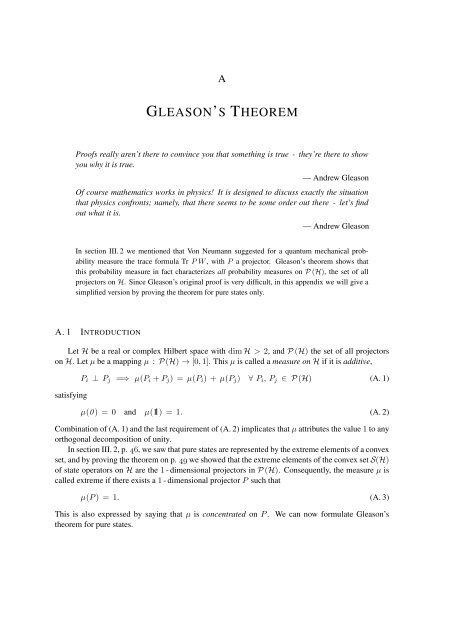FOUNDATIONS OF QUANTUM MECHANICS
FOUNDATIONS OF QUANTUM MECHANICS
FOUNDATIONS OF QUANTUM MECHANICS
You also want an ePaper? Increase the reach of your titles
YUMPU automatically turns print PDFs into web optimized ePapers that Google loves.
A<br />
GLEASON’S THEOREM<br />
Proofs really aren’t there to convince you that something is true - they’re there to show<br />
you why it is true.<br />
— Andrew Gleason<br />
Of course mathematics works in physics! It is designed to discuss exactly the situation<br />
that physics confronts; namely, that there seems to be some order out there - let’s find<br />
out what it is.<br />
— Andrew Gleason<br />
In section III. 2 we mentioned that Von Neumann suggested for a quantum mechanical probability<br />
measure the trace formula Tr P W , with P a projector. Gleason’s theorem shows that<br />
this probability measure in fact characterizes all probability measures on P (H), the set of all<br />
projectors on H. Since Gleason’s original proof is very difficult, in this appendix we will give a<br />
simplified version by proving the theorem for pure states only.<br />
A. 1 INTRODUCTION<br />
Let H be a real or complex Hilbert space with dim H > 2, and P (H) the set of all projectors<br />
on H. Let µ be a mapping µ : P (H) → [0, 1]. This µ is called a measure on H if it is additive,<br />
satisfying<br />
P i ⊥ P j =⇒ µ(P i + P j ) = µ(P i ) + µ(P j ) ∀ P i , P j ∈ P (H) (A. 1)<br />
µ(0 ) = 0 and µ(11) = 1. (A. 2)<br />
Combination of (A. 1) and the last requirement of (A. 2) implicates that µ attributes the value 1 to any<br />
orthogonal decomposition of unity.<br />
In section III. 2, p. 46, we saw that pure states are represented by the extreme elements of a convex<br />
set, and by proving the theorem on p. 49 we showed that the extreme elements of the convex set S(H)<br />
of state operators on H are the 1 - dimensional projectors in P (H). Consequently, the measure µ is<br />
called extreme if there exists a 1 - dimensional projector P such that<br />
µ(P ) = 1. (A. 3)<br />
This is also expressed by saying that µ is concentrated on P . We can now formulate Gleason’s<br />
theorem for pure states.
















